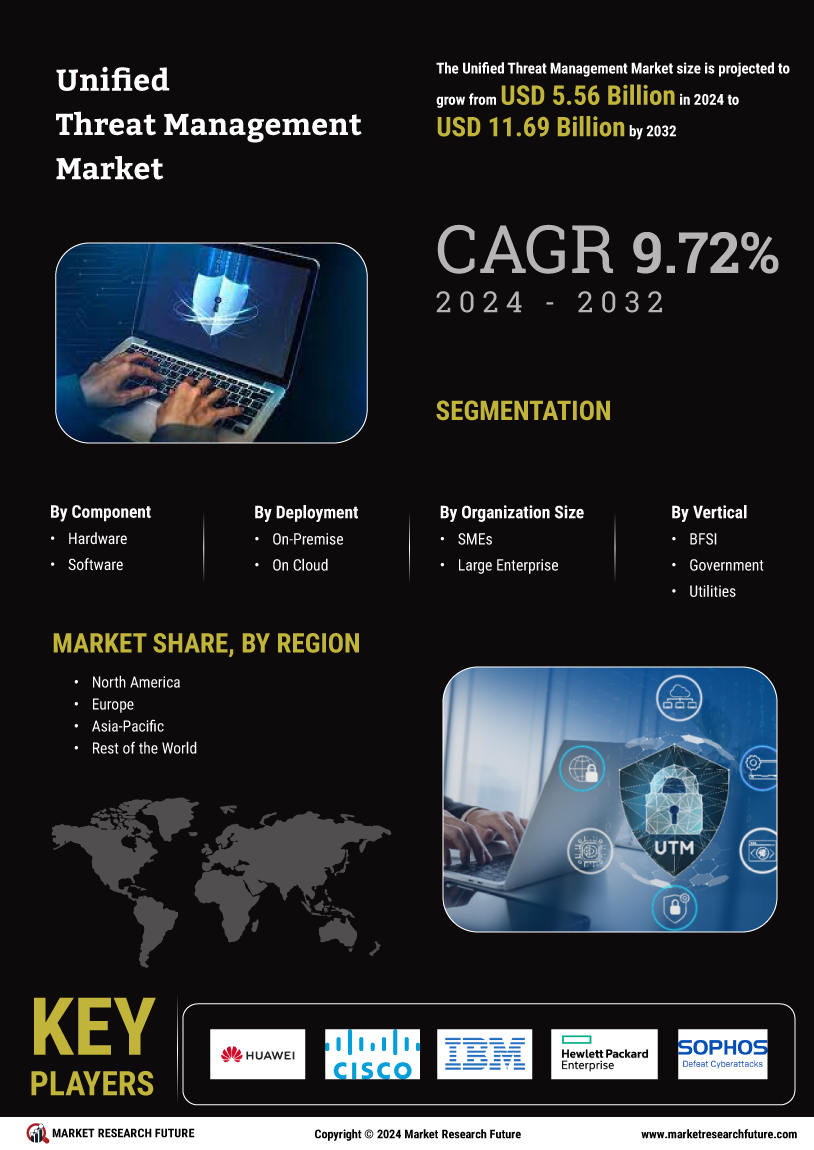Rising Cybersecurity Threats
The increasing frequency and sophistication of cyber threats is a primary driver for the Unified Threat Management Market. Organizations are facing a myriad of challenges, including ransomware attacks, phishing schemes, and advanced persistent threats. According to recent data, the global cost of cybercrime is projected to reach trillions of dollars annually, compelling businesses to invest in comprehensive security solutions. Unified Threat Management Market (UTM) systems offer an integrated approach to security, combining multiple functionalities such as firewall, intrusion detection, and antivirus into a single platform. This consolidation not only simplifies management but also enhances the overall security posture of organizations. As threats evolve, the demand for UTM solutions is likely to grow, reflecting the urgent need for robust cybersecurity measures.
Increased Regulatory Compliance
The evolving landscape of regulatory compliance is significantly influencing the Unified Threat Management Market. Organizations are increasingly required to adhere to stringent regulations such as GDPR, HIPAA, and PCI DSS, which mandate robust data protection measures. Failure to comply can result in severe penalties and reputational damage. UTM solutions facilitate compliance by providing comprehensive security features that help organizations safeguard sensitive data and maintain audit trails. The market for UTM is expected to expand as businesses seek to align their security strategies with regulatory requirements. In fact, a notable percentage of organizations report that compliance considerations are a key factor in their decision to adopt UTM solutions, indicating a strong correlation between regulatory pressures and market growth.
Adoption of Remote Work Policies
The shift towards remote work has emerged as a significant driver for the Unified Threat Management Market. As organizations embrace flexible work arrangements, the attack surface has expanded, necessitating enhanced security measures. UTM solutions are particularly well-suited for this environment, as they provide comprehensive protection for remote endpoints and secure access to corporate networks. The demand for UTM systems is likely to increase as businesses recognize the need to protect sensitive information in a decentralized work environment. Furthermore, studies indicate that a substantial portion of organizations plans to maintain remote work policies long-term, further solidifying the role of UTM solutions in safeguarding remote operations. This trend underscores the importance of integrated security solutions in addressing the unique challenges posed by remote work.
Growing Demand for Integrated Security Solutions
The trend towards integrated security solutions is a notable driver for the Unified Threat Management Market. Organizations are increasingly seeking to streamline their security infrastructure by consolidating multiple security functions into a single platform. UTM solutions offer a comprehensive suite of security features, including firewall, intrusion prevention, and content filtering, which can be managed from a centralized interface. This integration not only reduces complexity but also enhances the efficiency of security operations. Market data suggests that the demand for UTM solutions is on the rise, as organizations recognize the benefits of a unified approach to security. The ability to respond to threats in real-time and maintain a cohesive security strategy is becoming increasingly critical in today’s threat landscape, further propelling the growth of the UTM market.
Technological Advancements in Security Solutions
Technological advancements are playing a pivotal role in shaping the Unified Threat Management Market. Innovations in artificial intelligence, machine learning, and automation are enhancing the capabilities of UTM solutions, enabling them to detect and respond to threats more effectively. These advancements allow for real-time threat intelligence and automated responses, which are crucial in mitigating risks. As organizations become more aware of the potential of these technologies, the adoption of UTM solutions is expected to accelerate. Market analysts indicate that the integration of advanced technologies into UTM systems could lead to a substantial increase in market size, as businesses seek to leverage cutting-edge solutions to bolster their cybersecurity defenses. This trend highlights the importance of continuous innovation in the UTM market.


















Leave a Comment